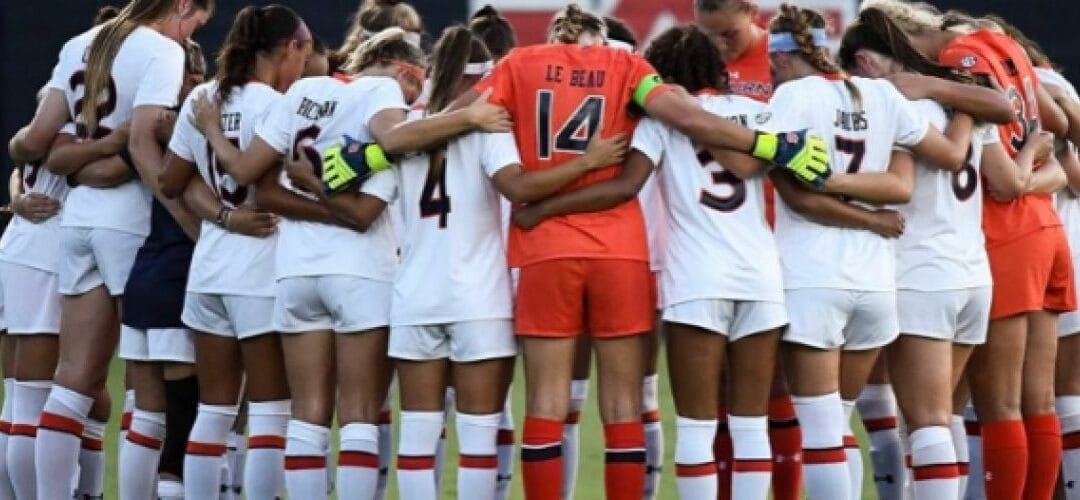(Photo: Auburn University soccer)
The landscape is sunny and the opportunities are vast, but the right strategy and tactics mean everything.
By Paul Culp, MA (Oxon.), CFT, GCDF, CCSP
A few weeks ago, we looked at athletic scholarships, seeking a realistic perspective on how widely available and how valuable they actually are (The “How Many” and “How Much” of Athletic Scholarships, September 18, 2018). We learned, to our surprise, that female scholarship athletes receive more funding per person, on average, than male scholarship athletes do. The pattern is consistent across the NCAA, NAIA, and NJCAA. We followed up with an article on women’s volleyball (Women’s Volleyball Scholarships by the Numbers, October 10) and were not at all surprised to learn that scholarship opportunities are much more abundant and more lucrative for women than for men.
We expected things to be a bit more even in soccer, perhaps with men having the upper hand (or foot), but instead we find that the odds of a female high school soccer player going on to play at the college level are much more favorable than for males, and that the financial statistics are more encouraging.
All in all, the expense and hoopla of football notwithstanding, female athletes are far from being a poor relation in intercollegiate athletics, and women’s soccer scholarships present attractive opportunities.
Unlike college volleyball, in which there are ten times as many female players as males, on ten times as many teams, soccer enjoys immense popularity with both sexes. According to Scholarshipstats.com, there are almost exactly the same number of male and female collegiate players: 39,858 men and 39,204 women, drawn from a pool of 456,362 high school males and 390,482 females. (In volleyball, by contrast, female high-schoolers outnumber males more than seven to one.) However, the opportunities for female soccer players are more numerous, relative to the number of athletes, than is the case for men.
Not quite 10 percent of female high school soccer players go on to play in college.
A total of 1,690 schools had varsity soccer programs in 2017-18, with women’s teams outnumbering men’s teams 1,591 to 1,420, not a huge difference. As noted above, there are nonetheless slightly more male than female players overall–the average roster size for men is higher–but the high school talent pool among males is also much larger. What all of this means is that the odds of a high school athlete playing varsity soccer are 18:1 for men and 13:1 for women, and in NCAA Division I the odds are 99:1 and 46:1, respectively.
Among female high-schoolers, 9.4 percent go on to compete in collegiate varsity soccer, as opposed to 7.5 percent for males. While only 2 percent of high school females secure a roster slot in Division I, that’s the double the percentage for males. (It’s also double the percentage for volleyball.)
Female soccer players seeking collegiate roster slots also face far less competition from foreign athletes than men do. Among men, foreign athletes account for 16 percent of soccer players in Division I and 20 percent in Division II, while the numbers for women are 21 percent and 5 percent, respectively. In Division III it’s about 3 percent for men and less than half a percent for women. In other words, Division I is tough, but foreign competition falls off sharply after that.
“Now, class, what do these two things have to do with each other?”

(Soccer ball by Ian Higbee, pie by Element5 Digital)
Now that we have some context, what about the scholarships themselves? Division I allows 14 scholarships per team for women, with 9.9 for Division II, 12 for the NAIA, and 24 for the NJCAA. At all levels, women’s programs have scholarship limits equal to or better than those for men. Men in Division I get only the 9.9 that women get in Division II.
But now the numbers take on a tricky aspect. Soccer, unlike women’s Division I volleyball, is not a head-count sport. In other words, there is not a one-to-one ratio between scholarships and athletes on scholarship. For example, in a head-count sport a $20,000 scholarship allotment is awarded in its entirety to one player. By contrast, in equivalency sports, of which soccer is one of many examples, that $20,000 allotment is divisible among as many players as the coaches see fit to assist.
That’s bad news in the sense that women’s soccer scholarships don’t guarantee a free ride, or anywhere near it. But the good news is that with women’s scholarship limits being equal to or greater than those for men, and with the average team size being smaller at all levels of the sport, the pie can be divvied up among fewer athletes.
In Division I, the only stratum for which we have a full complement of data, those 14 available scholarships are divided, on average, among 25 athletes. The most generous school (not identified by Scholarshipstats.com), distributes the 14 among only 17 fortunate souls, while the least generous shares the 14 among 33 athletes on what is a larger-than-average roster. The average scholarship is worth about $18,000, with the most valuable being about $31,000 and the low end being a little over $6,000.
Another reason not to be just a dumb athlete…
In this context it is important to bear in mind that athletic scholarships can be combined with other forms of financial aid, so a partial scholarship awarded on the equivalency plan can be treated as only one component of a financial aid strategy that involves assembling multiple forms of assistance.
As we reported in An Arm and a Leg and Your First-born Child: Why College Costs so Much (September 6, 2018), the average cost of tuition and fees for the 2017–2018 school year was $34,740 at private colleges and universities, $9,970 for state residents at public institutions, and $25,620 for out-of-state residents attending public institutions, according to the College Board. Depending on where an athlete chooses to go, the athletic scholarship might not cover all costs but may still offset a significant portion. Most do not constitute full free rides, but in soccer most of the arithmetic is better news for parents with daughters than it is for parents with sons.

(Photo: Samford University soccer)
Be forewarned that scholarships normally do not carry a four-year guarantee. Renewal can depend on a variety of factors, including athletic performance, grades, and good behavior. Being an academic standout and of strong character can only help you secure and keep a soccer scholarship.
As Athnet puts it, with more adamance than eloquence, “Make sure you are academic [sic] eligible…The college soccer recruiting process is very competitive. Competition for scholarship money is extremely competitive.”
It would be hard to argue with that. Arguing with that would be very competitive.
While Division III programs do not offer athletic scholarships, soccer can still be a ticket to financial aid. As we said elsewhere, “involvement in sports can be part of an extracurricular resume that colleges consider strongly in making decisions about whom to admit and whether to bestow financial aid. Thus it is possible, even without athletic scholarships, for athletic prowess and the desire to perform at the college level to play a role in the acquisition of financial aid for student-athletes applying at Division III schools.”
The financial aid battle for athletes is a little like Gettysburg: The landscape is nice and sunny, and the opportunities are vast, but the right strategy and tactics mean everything.
If you want a women’s soccer scholarship, you need The Coaching Educator.
Positioning yourself make sports pay for college can be a complex matter, and the process can vary greatly between sanctioning bodies. Nonetheless it obviously can be well worth the effort in terms of the benefits to your finances and college experience. The Coaching Educator has nearly a decade of experience helping high school athletes keep abreast of the regulations, timetables, procedures, and personal contacts that are essential components of a successful recruiting process. To learn more about our philosophy and capabilities, be sure to watch our free webinars, listen to our podcasts, sign up for our four-week College App Boot Camp, consider our Ultimate Programs and our special services for athletes and performing-arts students, and book a consultation to hear what we can do for you and how we do it. Keep reading this blog, and look for us on social media (see links below) as we keep our clients and admirers advised of new developments in our effort to help students get into and succeed at the right school.
Paul Culp is certified as a global career development facilitator and writes about college admissions, college costs, financial aid, and college life in general for The Coaching Educator team. A former journalist and corporate ghostwriter who now operates Shenandoah Proofreading, Editing & Composition Services (SPECS), he has also been a humanities teacher at all levels from university down to sixth grade. Paul has degrees from Oxford University, Jacksonville State University, and Samford University, and also is certified as a fitness trainer.
Recommended Reading About Athletic Scholarships
Culp, Paul. “Basketball Scholarships by the Numbers,” The Coaching Educator, 4 April 2019.
Culp, Paul. “The ‘How Many’ and ‘How Much’ of Athletic Scholarships,” The Coaching Educator, 18 September 2018.
Culp, Paul. “The ‘How To’ of Athletic Scholarships Explained,” The Coaching Educator, 24 November 2018.
Culp, Paul. “Lacrosse Scholarships by the Numbers,” The Coaching Educator, 6 December 2018.
Culp, Paul. “Ten Unusual Athletic Scholarships,” The Coaching Educator, 8 March 2019.
Culp, Paul. “Why Scholarship Athletes Quit,” The Coaching Educator, 25 February 2019.
Culp, Paul. “Women’s Volleyball Scholarships by the Numbers,” The Coaching Educator, 10 October 2018.
Support smart students and spread the word:
https://www.facebook.com/thecoachingeducator
https://www.youtube.com/user/KeirinCarroll
https://twitter.com/TCEducator
https://www.instagram.com/thecoachingeducator
https://www.linkedin.com/company/thecoachingeducator
Follow us on:
YouTube: https://tinyurl.com/yy5yssq8

